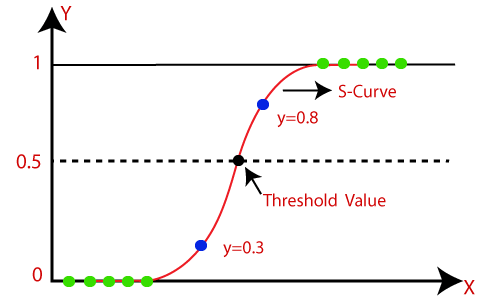📌 相关文章
- ML |线性回归
- ML |线性回归(1)
- 毫升 |线性回归与逻辑回归
- 毫升 |线性回归与逻辑回归(1)
- R-线性回归
- R线性回归(1)
- R-线性回归(1)
- R线性回归
- 线性回归 (1)
- 回归算法-线性回归
- 回归算法-线性回归(1)
- Python线性回归
- python中的线性回归(1)
- Python线性回归(1)
- ML——线性回归的优缺点(1)
- ML——线性回归的优缺点
- python代码示例中的线性回归
- 线性回归 - Javascript 代码示例
- 线性回归 - 无论代码示例
- 逻辑回归 - R 编程语言(1)
- 回归python(1)
- python 线性回归 - Python (1)
- R 编程中的逻辑回归(1)
- R 编程中的逻辑回归
- 逻辑回归 - R 编程语言代码示例
- TensorFlow-线性回归
- TensorFlow中的线性回归(1)
- TensorFlow-线性回归(1)
- TensorFlow中的线性回归
📜 ML-线性回归与逻辑回归
📅 最后修改于: 2020-09-28 05:52:10 🧑 作者: Mango
线性回归与逻辑回归
线性回归和逻辑回归是受监督学习技术的两种著名的机器学习算法。由于这两种算法本质上都是受监督的,因此这些算法使用标记的数据集进行预测。但是它们之间的主要区别在于它们的使用方式。线性回归用于解决回归问题,而逻辑回归用于解决分类问题。两种算法的描述以及差异表在下面给出。

线性回归:
- 线性回归是监督学习技术下最简单的机器学习算法之一,用于解决回归问题。
- 它用于在自变量的帮助下预测连续因变量。
- 线性回归的目标是找到可以正确预测连续因变量输出的最佳拟合线。
- 如果将单个自变量用于预测,则称为简单线性回归;如果有两个以上自变量,则将这种回归称为多重线性回归。
- 通过找到最佳拟合线,算法建立了因变量和自变量之间的关系。并且该关系应该是线性的。
- 线性回归的输出应仅是连续值,例如价格,年龄,薪水等。因变量和自变量之间的关系如下图所示:

在上图中,因变量在Y轴(薪水)上,自变量在x轴(经验)上。回归线可以写成:
其中,a0和a1是系数,而ε是误差项。
逻辑回归:
- 逻辑回归是监督学习技术下最受欢迎的机器学习算法之一。
- 它既可以用于分类问题,也可以用于回归问题,但主要用于分类问题。
- 逻辑回归用于在自变量的帮助下预测分类因变量。
- Logistic回归问题的输出只能在0和1之间。
- 在需要两类之间的概率的情况下,可以使用逻辑回归。例如今天是否下雨,0或1,对还是错等等。
- Logistic回归基于最大似然估计的概念。根据此估计,观察到的数据应该是最有可能的。
- 在逻辑回归中,我们将输入的加权和通过激活函数传递,该函数可以映射介于0和1之间的值。这种激活函数称为Sigmoid 函数 ,获得的曲线称为Sigmoid曲线或S曲线。考虑下图:

- Logistic回归方程为:

线性回归和逻辑回归之间的区别:
| Linear Regression | Logistic Regression |
|---|---|
| Linear regression is used to predict the continuous dependent variable using a given set of independent variables. | Logistic Regression is used to predict the categorical dependent variable using a given set of independent variables. |
| Linear Regression is used for solving Regression problem. | Logistic regression is used for solving Classification problems. |
| In Linear regression, we predict the value of continuous variables. | In logistic Regression, we predict the values of categorical variables. |
| In linear regression, we find the best fit line, by which we can easily predict the output. | In Logistic Regression, we find the S-curve by which we can classify the samples. |
| Least square estimation method is used for estimation of accuracy. | Maximum likelihood estimation method is used for estimation of accuracy. |
| The output for Linear Regression must be a continuous value, such as price, age, etc. | The output of Logistic Regression must be a Categorical value such as 0 or 1, Yes or No, etc. |
| In Linear regression, it is required that relationship between dependent variable and independent variable must be linear. | In Logistic regression, it is not required to have the linear relationship between the dependent and independent variable. |
| In linear regression, there may be collinearity between the independent variables. | In logistic regression, there should not be collinearity between the independent variable. |